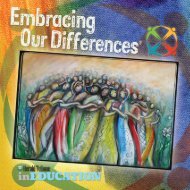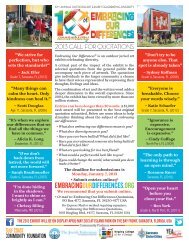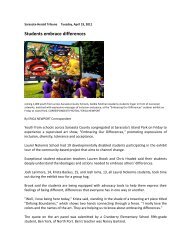Diversity - Embracing Our Differences
Diversity - Embracing Our Differences
Diversity - Embracing Our Differences
Create successful ePaper yourself
Turn your PDF publications into a flip-book with our unique Google optimized e-Paper software.
BUILDING BRIDGES<br />
T<br />
hroughout history, there are<br />
hundreds of examples of nations<br />
battling their neighbors over land,<br />
beliefs, or even life style. Research<br />
the turmoil in one of the following<br />
countries in your school media center<br />
or local library: Ireland South Africa, Israel, Iraq,<br />
Vietnam, United States of America, Sierra Leone,<br />
Bosnia-Serbia, Yugoslavia, Iran, Korea, Germany,<br />
Rwanda, Somalia, Lebanon, Ukraine, Guatemala,<br />
Chile, El Salvador, Uganda, Nicaragua, Cambodia,<br />
Kosovo, Tibet, East Timor, Republic of the Congo,<br />
and Poland.<br />
Israel has adopted several educational programs<br />
promoting coexistence. Although there are many<br />
differences between neighbors, in order to promote<br />
coexistence, one must embrace the similarities and<br />
celebrate the differences in culture. Here are some<br />
“rules of the road” when building bridges and developing<br />
programs to foster coexistence.<br />
• Recognize the importance of language:<br />
Language is at the base of one’s national identity.<br />
Just as language creates bridges and ties between<br />
people, it can be an obstacle to contact. Language<br />
differences must be taken into account. On the other<br />
hand, the study of language can be used as a bridge<br />
for coexistence.<br />
• Coexistence can be an unstated goal: The<br />
premise behind the experiential programs is to<br />
engage parties in joint activities that everyone<br />
enjoys. The close proximity will, over time,<br />
promote coexistence.<br />
• Teachers and administrators must support<br />
projects run in their schools: The principal must<br />
demonstrate a clear interest in the program to insure<br />
it is viewed as an important component of the curriculum.<br />
Similarly, teachers’ support is vital to encouraging<br />
student participation and supporting the changes<br />
resulting from the program.<br />
• Parents should be involved: The support and<br />
cooperation of parents are essential. Projects should<br />
be viewed as an opportunity to spread the message<br />
of coexistence beyond the classroom and into homes<br />
and communities. Joint activities that involve the<br />
communities and parents foster mutual tolerance.<br />
• Preparation is needed prior to interactions:<br />
Before engaging in any joint activities, it is important<br />
to spend time preparing for the meetings. Students<br />
and teachers should be intimately involved in planning<br />
the interactions. Sessions to examine stereotyped<br />
thinking, generalizations and prejudice are<br />
important to prepare groups for encounters. The<br />
establishment in advance of clear rules also makes<br />
meetings work more harmoniously.<br />
• Promoting coexistence is facilitated by government<br />
support: The Israeli Ministry of Education<br />
provides an example of how a governmental body<br />
can play an important role in introducing coexistence<br />
projects into the schools.<br />
• Careful student selection enhances prospects<br />
for success: Highly motivated students will influence<br />
their peers.<br />
• It is important for projects to be consistent<br />
and ongoing: Ongoing multiyear programs reinforce<br />
a consistent commitment to improving crosscultural<br />
relations.<br />
– Source: The American-Israeli Cooperative Enterprise<br />
at www.jewishvirtuallibrary.org<br />
Activity<br />
Talk Is Cheap<br />
ABOUT THE ARTWORK:<br />
“Awesome” by Sarah Carr, 12th Grade, Port Charlotte High School, Port Charlotte,<br />
Florida , Teacher: Tiffany Coffey<br />
ARTIST STATEMENT: “A lot of people walk around thinking they are totally separate<br />
from each other. I believe we are all together and there to help one another. I explored<br />
the idea of six people handcuffed to each other, forced to be together - in hopes they<br />
will discover they are more alike than they imagine.”<br />
06<br />
EMBRACING OUR DIFFERENCES<br />
How do we talk about people when<br />
they are not around?<br />
Write down how you think<br />
or talk about the following:<br />
My School<br />
My Class<br />
My Neighborhood<br />
With My Friends<br />
In the World<br />
How can you change the way you talk about these<br />
areas to foster acceptance of diversity?<br />
A Question of Unity. Just because I’m a different race, why do you hate me? Just because I’m young, why do you<br />
not trust me? Just because I’m a little bit overweight, why do you taunt me? Just because I am different.<br />
– Derrek Gunnells, 8th Grade, Booker Middle School, Sarasota, Florida<br />
A Herald-Tribune Media Group Newspaper-in-Education Publication














